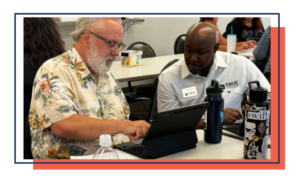 Creating an inclusive classroom isn’t just a strategy—it’s a commitment to fostering a space where all students feel valued, respected, and empowered. At The Core Collaborative, we believe that creating such a culture requires not only understanding the principles of inclusivity but also examining our personal behaviors and mindsets that might unintentionally hinder this goal.
Creating an inclusive classroom isn’t just a strategy—it’s a commitment to fostering a space where all students feel valued, respected, and empowered. At The Core Collaborative, we believe that creating such a culture requires not only understanding the principles of inclusivity but also examining our personal behaviors and mindsets that might unintentionally hinder this goal.
Step 1: Educate Yourself on Inclusivity
The first step in creating an inclusive classroom is self-education. Understand what inclusivity truly means. It’s not just about making sure everyone has a seat at the table; it’s about ensuring that every voice is heard, valued, and respected. This involves learning about different cultures, abilities, learning styles, and backgrounds. But it also means reflecting on your own biases and how they might affect your teaching.
 Step 2: Identify Personal Behaviors That Disrupt Inclusive Classrooms
Step 2: Identify Personal Behaviors That Disrupt Inclusive Classrooms
We all carry biases, whether we realize it or not. These biases can subtly influence how we interact with students, which voices we amplify, and how we design our curriculum. By identifying and addressing these behaviors, we can prevent them from disrupting the inclusive environment we seek to create.
Ask yourself, “Am I providing equal opportunities for all students to participate? Do I make assumptions about students based on their backgrounds or abilities?”
Step 3: Create and Sustain a Culture of Belonging and Critical Thinking
An inclusive classroom is one where every student feels they belong. This requires more than just inviting students to participate. It means actively creating a space where students feel safe to express themselves, take risks, and engage in critical thinking. Encourage open dialogue, celebrate diversity, and create assignments that allow students to bring their unique perspectives into the classroom. By fostering a culture of belonging, you empower students to think critically and challenge their assumptions.
Step 4: Practice Inclusivity Daily
 Inclusivity is not a one-time effort; it’s a daily practice. This means continuously reflecting on your teaching methods, adapting your approach to meet the needs of all students, and being mindful of the language you use. Small daily actions, like using inclusive language, checking in with students, and being open to feedback, contribute to creating and maintaining an inclusive classroom.
Inclusivity is not a one-time effort; it’s a daily practice. This means continuously reflecting on your teaching methods, adapting your approach to meet the needs of all students, and being mindful of the language you use. Small daily actions, like using inclusive language, checking in with students, and being open to feedback, contribute to creating and maintaining an inclusive classroom.
Here are six ways of small daily actions that can contribute to fostering inclusivity and building relationships in a school setting:
- Using Inclusive Language: Regularly using language that affirms all identities and avoids assumptions about gender, background, or abilities (e.g., “everyone” instead of “guys,” or “they” as a gender-neutral pronoun).
- Checking in with Students: Take a few minutes each day to ask students how they are feeling or if there’s anything they need support with. This can be done during attendance or informal moments throughout the day.
- Celebrating Diversity: Use your knowledge of the personal culture of your students to acknowledge and celebrate the cultural events and days that are important to them. Sharings these features of culture creates opportunities for deeper discussions of the specific traditions, contributions, and achievements of the various groups represented.
- Encouraging Participation from All Students: Actively inviting quieter students to share their thoughts or perspectives in a supportive way, ensuring all voices are heard.
- Providing Positive Feedback: Recognize and praise not just academic achievements but also positive behaviors, such as kindness, teamwork, and perseverance, to reinforce a culture of respect and support.
- Modeling Respectful Behavior: Consistently demonstrate respectful behavior in interactions with both students and colleagues, showing how to engage in constructive, inclusive communication.
Step 5: Codify Inclusivity in District, School & Classroom Policies
Finally, it’s essential to codify these inclusive practices into classroom policies. This could mean creating clear agreements for respectful communication, establishing procedures for addressing conflicts, and ensuring that your syllabus reflects a commitment to diversity and inclusion. When inclusivity is embedded in your policies, it becomes a fundamental part of your classroom culture, rather than an afterthought.
By following these steps and continually reflecting on your practices, you can create an inclusive classroom that fosters belonging, critical thinking, and a commitment to equity.
Sources:
- Gorski, P. C. (2016). Reaching and Teaching Students in Poverty: Strategies for Erasing the Opportunity Gap. Teachers College Press.
- Gay, G. (2018). Culturally Responsive Teaching: Theory, Research, and Practice. Teachers College Press.
- Ladson-Billings, G. (1995). Toward a Theory of Culturally Relevant Pedagogy. American Educational Research Journal, 32(3), 465-491.
- Banks, J. A. (2004). Multicultural Education: Historical Development, Dimensions, and Practice. In the Handbook of Research on Multicultural Education (pp. 3-29). Jossey-Bass.
- Bates, T. (2024, August, 26). Empowering Through Education and Inclusivity. LinkedIn. https://www.linkedin.com/pulse/empowering-through-education-inclusivity-tyrone-bates-jr-ed-d–hb0kc?utm_source=share&utm_medium=member_ios&utm_campaign=share_via
Are you ready to create schools that work for all of us?
Build a multigenerational approach for equity with Youth Equity Stewardship (YES). YES is the only multi-generational equity pathway that activates and sustains authentic partnerships between adults and students, leading to a compelling, vibrant, culturally responsive, and sustaining learning community.
YES! PLEASE

